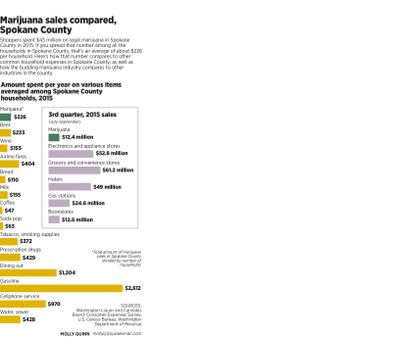Marijuana sales top spending on wine and milk in Spokane County

Legal marijuana sales in Spokane County topped retail sales of wine and kitchen staples such as bread and milk last year.
That’s according to sales numbers from the Washington Liquor and Cannabis Board and a survey of household expenses conducted by the U.S. Census Bureau.
Not all marijuana sold in Spokane County is consumed by county residents. State law allows the 17 state-licensed pot shops in the area to sell to anyone older than 21, regardless of where they live.
But with monthly sales topping $5 million for the first time in March, retailers in the county are selling marijuana at an ever-quickening pace – on track to top receipts at area bookstores, museums and live music venues, according to figures released by the Washington Department of Revenue.
Spokane County marijuana retailers reported just over $43 million in sales in 2015, according to the state Liquor and Cannabis Board. That’s an average of $225.64 per household.
By comparison, retail beer sales were $232.70 per Spokane County household last year, according to the Consumer Expenditure Survey administered by the Census Bureau. The average household spent $154.85 on wine, $155.37 on milk and $109.71 on bread in 2015.
The calculated marijuana average ignores the “80/20 rule” – 20 percent of people are responsible for 80 percent of an effect, said Brian Smith, Liquor and Cannabis Board spokesman. An independent study by the Rand Corp. in 2013 found the rule applied to Washington’s nascent marijuana market – that roughly one-fifth of the population accounted for the vast majority of marijuana sales.
The Liquor and Cannabis Board tracks marijuana sales of $2.8 million a day statewide, Smith said. “That seems pretty robust,” he said.
Grant Forsyth, chief economist at Avista Corp. and an adviser on industry trends to local governments, said it’s difficult with available data to compare spending on marijuana with other household items. The federal government administers the Consumer Expenses Survey and also classifies marijuana as a controlled substance, hindering efforts to study the purchase of pot with the same rigor as other household expenditures.
“We don’t have a lot of consumption data, so it’s hard to see how the market is going to evolve,” Forsyth said.
Smith said comparing total marijuana revenues to receipts reported by the Washington Department of Revenue might provide a clearer comparison of marijuana’s economic effect on the region.
For the third quarter of 2015 – July through September – marijuana sales in Spokane County reached $12.4 million. That’s slightly less than bookstore revenue of $12.6 million and is below the $15.8 million generated from arts, entertainment and recreation, including live music venues and museums, during that period – the most recent for which the comparative data are available.
Marijuana sales rose further in the county in the first quarter of 2016 to $14.5 million. That includes a slight decline in sales in January over December. Total revenues are likely to continue to increase, as medical marijuana dispensaries will come under Liquor and Cannabis Board control in July.
Because state laws were rewritten last year to enable tax revenue sharing with local governments based on sales, more revenue means more money for cities and counties. Spokane County can expect to receive $442,917 from the state in excise taxes on marijuana this year, according to the most recent Liquor and Cannabis Board estimates. The city of Spokane will be allotted $123,011; Spokane Valley, with its moratorium on new businesses, will be capped at $75,824.